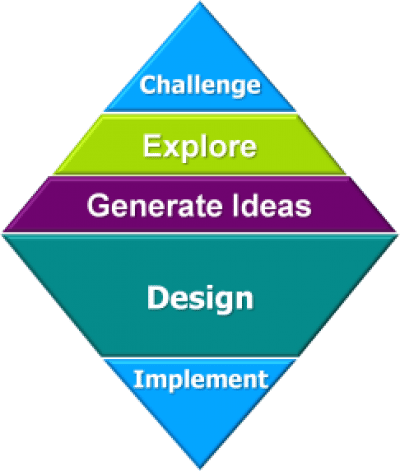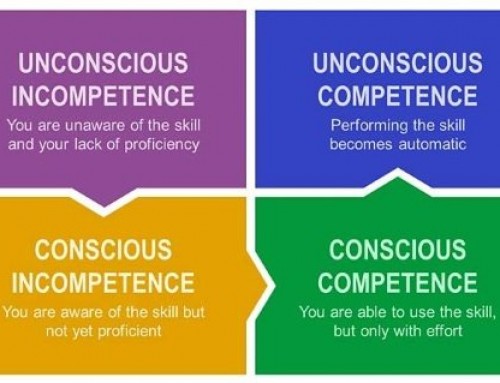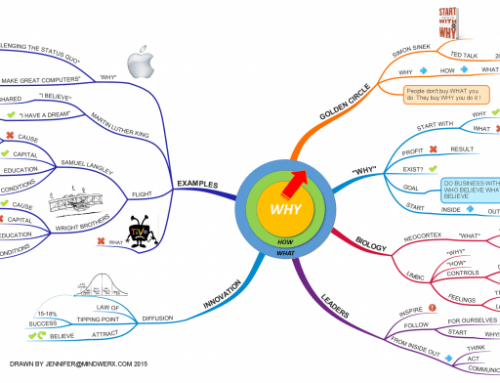 One of the challenges faced by organisations adopting deliberate thinking to help promote innovation is connecting new thinking techniques to real and important issues in the organisation.
One of the challenges faced by organisations adopting deliberate thinking to help promote innovation is connecting new thinking techniques to real and important issues in the organisation.Deliberate thinking begins with an appreciation of the organisation’s Vision. Vision includes the purpose, values, long-term goals and aspirations of key stakeholders, and is deployed throughout the organisation.
The Vision provides the inspiration and reason for all actions, and helps ensure that thinking is effectively directed and held on course. If you don’t know where you’re going, any road will get you there.
Business planning is done to set SMART objectives, tactical actions, as well as team and individual job descriptions and performance plans. Plans have targets and measures for success and feed the deliberate thinking process – that is plans tell us what needs to be done, so thinking can be directed to achieve them.
1. Focus the Thinking
This step involves ‘choosing’ what to think about. While everyone always has lots ‘to do’, what is seldom done is to clarify what ‘to think about’. This will involve thinking about daily tasks, current objectives, and achieving performance plans. In deliberate thinking terms, tools that assist this step include:
- Areas of Opportunity – looking beyond the day to day to areas where thinking would be of value
- Your Creative Hit List – documenting 20-25 things to think about – short, medium and long-term. Problems, tasks, improvements, wishes and dreams
- Imagineering – visualising the desired future and comparing it to the current situation, in order to identify the Gap between them
- Focus Statements – specifically designed to target the thinking and keep it on track
2. Plan the Thinking
Once we know what we want to think about, we can think about how to do the thinking. This is the essence of Deliberate or what is often called Critical Thinking – that is that mode of thinking, about any subject, content, or problem – in which the thinker improves the quality of his or her thinking by skillfully taking charge of the structures inherent in thinking and imposing intellectual standards upon them.
For Deliberate Creative Thinking one of the best models for planning the thinking is the divergent-convergent approach initially developed by Alex Osborn and Sid Parnes as part of the Creative Problem Solving Institute (CPSI). A slightly modified version used by Mindwerx is shown below.

For the leader planning to bring a team together to address a specific issue, or in directing the day to day operation of the business, there is a need to put effort into designing an approach to thinking that optimizes team performance in achieving the organisation’s goals. To aid this, the leader can use or consider the following:
- Focus, People & Time – the three vital ingredients in any every thinking activity.
- Is the Focus clear, are the best people to do the thinking effectively engaged, and has sufficient time been allocated for each thinking stage?
- Blue Hat – the organisation and facilitation hat of de Bono’s Six Thinking Hats®.
- Use this to set the focus, determine what thinking approaches and tools are needed.
- Thinking Tools – What type of tool is needed? Radiant thinking to start the flow of association. Parallel Thinking for collaborative team thinking. Lateral thinking to provoke and open new pathways and ideas. Directed thinking to dig deeper and aid decision making. Specific tools that may be considered:
- Mind Maps – hand-drawn, group maps, software
- Six Thinking Hats – a simple framework for parallel thinking
- Brainstorming to start the flow of ideas
- Random Word and PO to provoke new ideas
- Concept Fans to build ideas on ideas
- …. there are many tools available
3. Do the Thinking
Deliberate thinking is designed to guide and open up thinking, not constrain it. While some time is spent in planning a thinking activity, when doing the thinking the aim is to bring efficiency, effectiveness and creativity into play. A leader guides the team through the thinking process, seeking to ‘facilitate’ with the tools chosen, adhering to the tool’s principles as much as possible. To aid the thinking process a leader considers:
- Preparing for the thinking by setting up the environment
- Where will it be done, what equipment is needed, what information should be prepared and available, what ‘extras’ are needed (coffee, catering, props, guest speakers, etc)
- If Mind Mapping is used, flip charts are suitable for hand-drawn group maps, software (MindGenius, iMindMap) can be projected using a data projector so the team can help create an active group map
- If using Six Thinking Hats would Zing Technology increase creativity and engage the full team more. It certainly assists parallel thinking.
- If Lateral Thinking will be needed, what type of provocation will add value – are any props needed, what about real or virtual excursions?
- Time management is vital in doing the thinking, so have a plan and watch the time, always checking that progress is being made. Use the Blue Hat to reinforce the focus, and adapt the agenda as needed. Don’t ‘wing it’.
- If there is potential for difficult team dynamics (Forming, Storming, Norming, Performing) what approach will be used to encourage collaboration?
4. Making Decisions
When a thinking activity is well planned and facilitated, a challenge or situation will be more fully understood and, if idea generation was done, there may be many different and sometimes unexpected options now available to the team. This can lead to problems with decision making and a leader is responsible for being clear right up front on how decisions will be made. The most common approach is for a team to present designs, options and recommendations to a senior person or group (e.g. Board).
The team will need to weigh up alternatives, prepare recommendations, and present these well – often in both written and spoken formats. Leaders can help teams by clarifying decision making criteria and insisting that a deliberate, logical and transparent process is used in preparing and presenting recommendations. In addition to, and usually prior to, any standard organisational decision making protocols, this can be done using a wide range of tools, including:
- DATT – the ten tool toolkit developed by Edward de Bono (see other article) which allows for a thorough assessment and further development of emerging solutions
- In particular DOCA – Decision/Design Outcome Channel Actions
- Decision Grids – matrix tools that allow multiple options to be weighed again multiple criteria
- Kepner Tregoe – KT provides a range of effective decision analysis and making tools
5. Taking Actions
Nothing happens, if nothing happens, and yet procrastination is one of the biggest problems in organisations today – and the further down the organisation the worse it gets. To be successful, hundreds of positive, well thought through actions need to be taken every day – but most are delayed because of a lack of confidence. This leads to a significant waste of time and effort in endless meetings, while opportunities are lost.
When an organisation’s leaders support, promote and undertake deliberate thinking we see confidence grow as people at all levels know that a situation has been well thought through, using approved methods, and is inline with understood and transparent protocols. Techniques that leaders can promote to encourage positive action include:
- Mind Mapping software used in earlier stages have project management capabilities to allocate responsibilities, resources, timeframes etc and can be exported into MS Project, PowerPoint, Word, Visio, etc
- Organisational team and individual Performance Plans can detail medium (e.g. quarterly) actions, with clarity on how progress and success is measured
- A range of process improvement and statistical process control tools may be valuable to ensuring that actions are having the planned impact
6. Review and Improve
No matter how effective deliberate thinking may be when applied to complex issues, there will always be room for improvement, which requires a review of the thinking process that again should be done deliberately. For more than a hundred years the classic Plan-Do-Study-Act cycle has guided continuous improvement efforts, and leaders do themselves and their people a huge service when they apply this to deliberate thinking activities.
If a project or outcome is less successful than expected or needed, there is little value in seeking to blame and punish. Deliberate thinking promotes a clearer understanding of a starting situation, a view of the preferred future situation, a transparency in what is done to develop and implement solutions, and open and collaborative teamwork.
This allows for a valuable review to identify and undertake improvements for the next important thinking activity. And creates a culture where collaboration, creativity and active thinking promote innovation.
Close
The development of a culture of innovation in an organisation has many facets, and the use of deliberate thinking methods and tools, particularly Deliberate Creative Thinking techniques is one important aspect. By understanding and applying proven techniques in a thoughtful way, behaviour is changed, and when rewarded with success, this change in behaviour leads to new habits, protocols, processes and attitudes. It is not a quick change process, although the use of thinking tools can do, it does work and is sustainable.
What is required is leadership, focus on vision, and discipline.
The Mindwerx Deliberate Creativity & Innovation programs are designed to start the learning process for people at all levels. Learn more about our tailored in-house program, and our fully online program now






Leave A Comment
You must be logged in to post a comment.